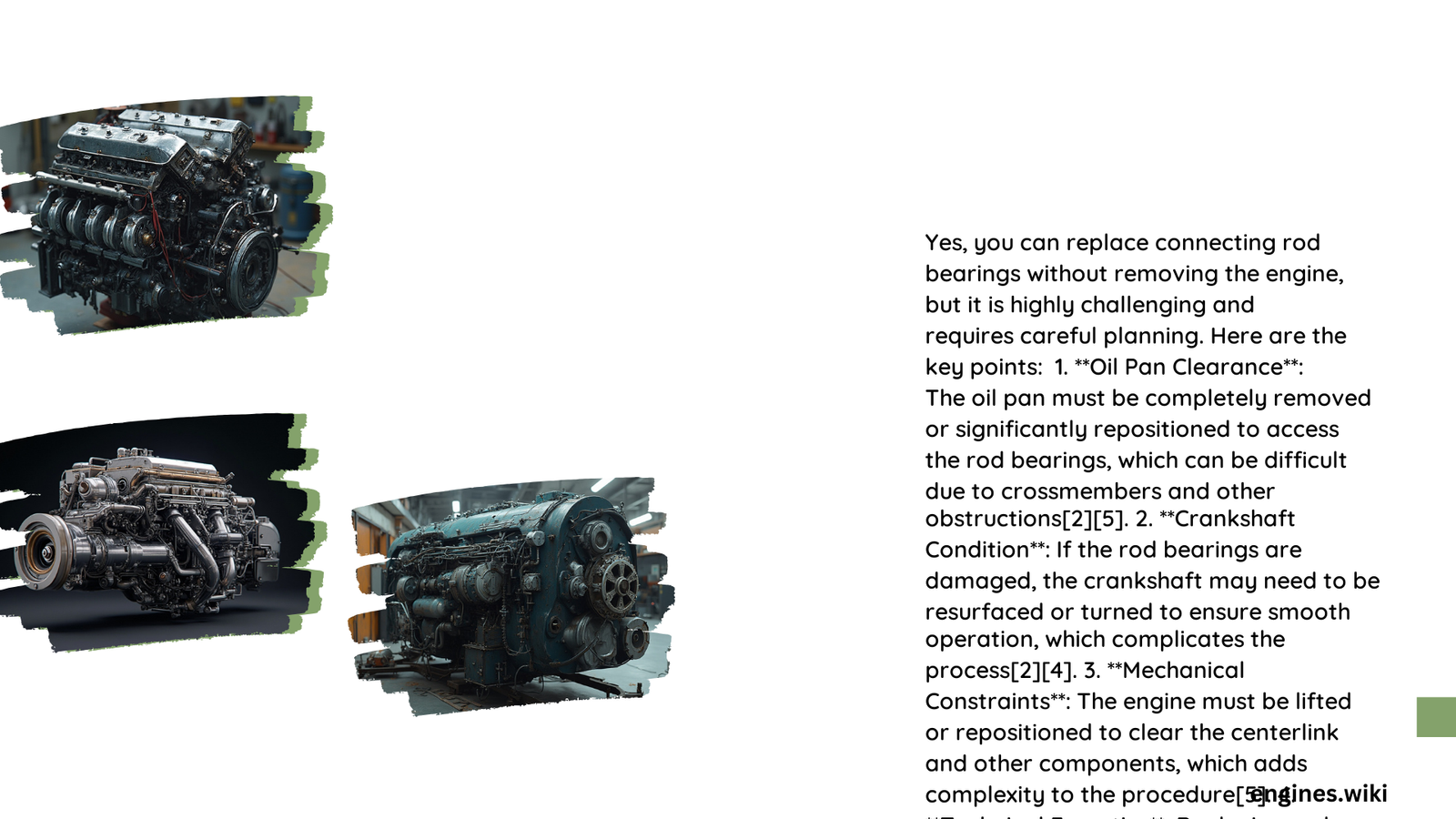Replacing connecting rod bearings without removing the engine is a complex but feasible task under certain conditions. This process requires careful planning, specialized tools, and a deep understanding of engine mechanics. While it’s possible for some engine configurations, others may necessitate full engine removal. This article explores the feasibility, techniques, and challenges of replacing connecting rod bearings in situ.
What Are the Key Factors in Determining Feasibility?
Several factors influence whether you can replace connecting rod bearings without removing the engine:
- Engine Configuration: Inline engines often provide easier access compared to V-type engines.
- Vehicle Design: Some vehicles offer better undercarriage access than others.
- Available Tools: Specialized tools like a piston ring compressor and bearing puller are essential.
- Mechanic’s Skill Level: This job requires advanced mechanical knowledge and experience.
How Do You Access the Connecting Rod Bearings?

Accessing the connecting rod bearings without removing the engine involves these steps:
- Raise and secure the vehicle on jack stands.
- Drain the engine oil.
- Remove the oil pan, which may require disconnecting various components.
- Locate the connecting rods and their bearing caps.
What Tools Are Necessary for This Procedure?
To replace connecting rod bearings in situ, you’ll need:
- Socket set and wrenches
- Torque wrench
- Piston ring compressor
- Bearing puller
- Plasti-gauge
- Engine hoist or lift (for better access)
- Oil pan gasket and sealant
What Are the Steps to Replace the Bearings?
- Remove the bearing caps and old bearings.
- Clean the crankshaft journal and connecting rod surfaces.
- Install new bearings, ensuring proper alignment.
- Use plasti-gauge to check oil clearance.
- Reinstall bearing caps to the correct torque specification.
- Repeat for each connecting rod.
- Reinstall the oil pan with a new gasket.
What Challenges Might You Face During This Process?
Replacing connecting rod bearings without removing the engine presents several challenges:
- Limited workspace
- Risk of damaging other engine components
- Difficulty in achieving proper bearing alignment
- Potential for incomplete replacement
- Time-consuming process compared to full engine removal
When Is Engine Removal Necessary?
Engine removal becomes necessary in these situations:
- V-type engines with limited access
- Vehicles with complex undercarriage designs
- When additional repairs (e.g., crankshaft resurfacing) are needed
- If the risk of damaging other components is too high
What Are the Risks of In-Situ Bearing Replacement?
Attempting to replace connecting rod bearings without removing the engine carries risks:
- Improper installation leading to premature bearing failure
- Damage to the crankshaft or connecting rods
- Oil leaks due to improper oil pan reinstallation
- Incomplete repair if all bearings can’t be accessed
How Does This Procedure Affect Engine Performance?
When done correctly, replacing connecting rod bearings in situ should:
- Restore proper oil clearances
- Reduce engine noise
- Improve oil pressure
- Extend engine life
However, if not performed properly, it can lead to:
- Increased engine wear
- Poor performance
- Potential catastrophic engine failure
What Precautions Should Be Taken?
- Consult the vehicle’s service manual for specific procedures and torque specifications.
- Work in a clean environment to prevent contamination.
- Use high-quality replacement bearings.
- Double-check all measurements and clearances.
- Consider professional help if you’re unsure about any step.
Is This a Cost-Effective Approach?
Replacing connecting rod bearings without removing the engine can be cost-effective if:
- You have the necessary skills and tools
- The engine configuration allows for easy access
- No additional repairs are needed
However, if complications arise, it may end up being more expensive than a full engine removal and overhaul.
In conclusion, while it is possible to replace connecting rod bearings without removing the engine in some cases, it’s a challenging task that requires careful consideration. For many vehicles, especially those with V-type engines or complex designs, full engine removal may still be the safer and more efficient option.
References:
1. Heavy Duty Pros – Can You Replace Rod Bearings Without Pulling the Engine?
2. Ford Forum – Can you replace rod bearings without removing engine just the oil pan?
3. Team Integra Forums – Rod bearings w/o crank/head removal?
